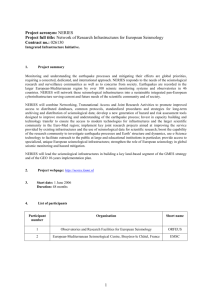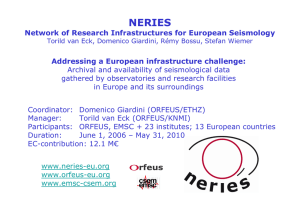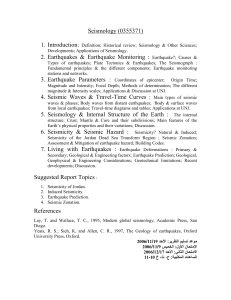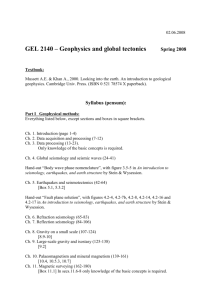Data challenges in Earthquake Seismology Torild van Eck ORFEUS FDSN
advertisement
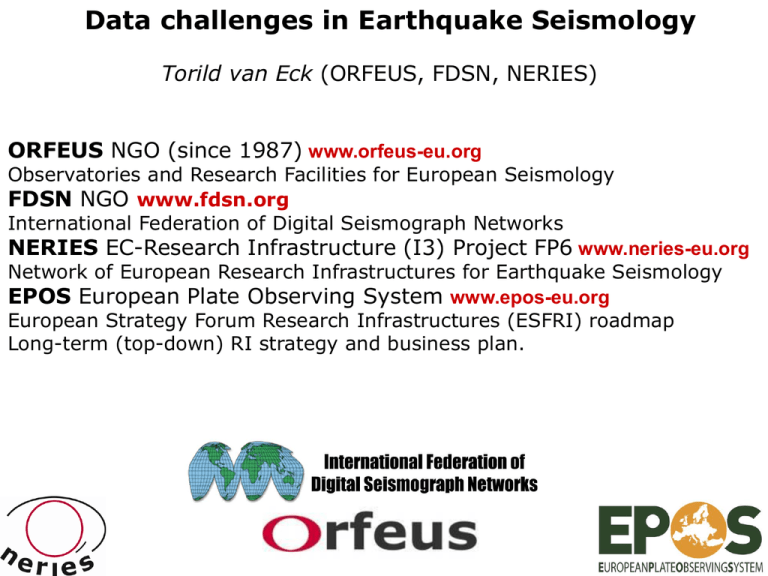
Data challenges in Earthquake Seismology Torild van Eck (ORFEUS, FDSN, NERIES) ORFEUS NGO (since 1987) www.orfeus-eu.org Observatories and Research Facilities for European Seismology FDSN NGO www.fdsn.org International Federation of Digital Seismograph Networks NERIES EC-Research Infrastructure (I3) Project FP6 www.neries-eu.org Network of European Research Infrastructures for Earthquake Seismology EPOS European Plate Observing System www.epos-eu.org European Strategy Forum Research Infrastructures (ESFRI) roadmap Long-term (top-down) RI strategy and business plan. European and global coordination in earthquake seismology IUGG / IASPEI (Global) International Association of Seismology and Physics of the Earth GEO - Group on Earth Observations FDSN (global) International Federation of Digital Seismograph Networks ESC (EuroMed) European Seismological Commission (EuroMed) Observatories and Research Facilities for European Seismology Board of Directors Executive Committee Participants (EuroMed) European Mediterranean Seismological Center Assembly of all members Coordination bureau Executive Council Some data challenges in Earthquake Seismology Earthquake Monitoring since around 1895 International data exchange and standards established early on. Seismological data analysis since around 1950 Signal processing, tomography, ambient noise imaging, … Advanced computer analysis early on. Data challenges on the observational side: Gathering – monitoring, transfer, storage, Analysis – real-time, information processing, Quality – metadata, Quality Control, formatting standards, Access – archival and distribution, Data challenges on the modelling side: Wave propagation through complex media Rupture process modelling in inhomogeneous media More recent data challenges in Earthquake Seismology Matching modelling and observation Waveform inversion (large amounts of data and computational resources) Rapid (near-real-time) data analysis Rapid earthquake warning (seconds) Tsunami warning (seconds to hours) Rapid earthquake information (seconds to hours) Broad data access and availability (educational and scientific) Data provenance, quality, Integrated visualisation and computing facilities Data management, exchange, Distributed resources Combining data archives, computational resources, shared analysis tools Monitoring infrastructure: seismological networks Data ownership: National monitoring interests (hazard, warning, etc) Regional Coordination: Parameter data EMSC Waveform data ORFEUS ~4’000 stations >180 networks Current projects: NERIES (EU) GEOFON (GR) GEOSCOPE (FR) MEDNET (I) Accelerometer networks and data 3,868 Total: stations 1,402 free field 1,905 on struct 233 on dam 20 boreholes Virtual European Broadband Seismic Network (VEBSN) (near)Real-time Data exchange Contributors: >53 networks Data archival: at ODC Coordination + EC funding: MEREDIAN (EU) NERIES (EU) NERA proposal (EU) ORFEUS (NGO) Status January 2010 ~ 450 BB stations Progress: ~ 50 stations/yr OBS deployments and data integration IPGP INGV AWI 30 June 2008 NERIES second Annual meeting Global earth models and (waveform) Tomography Waveform forward modelling and observation analysis Courtesy, SPICE project (EC) Seismic wave Propagation and Imaging in Complex media: a European network Tools: European Reference model Shear-wave speed variation Earthquake rupture modelling Strong motion modelling http://earthquake.usgs.gov/regional/nca/simulations/shakeout/ Courtesy: .US Geological Survey and the Southern California Earthquake Center Seismic imaging using seismic noise Example for the Alpine region in Europe Group velocity Map Rayleigh Waves (5 sec) Moho depth in the Alpine region 3500 paths with reliable group Velocity. Number of paths crossing each ‘cell’ Stehly et al, 2008 Tools: Real Time Hazard and Rapid warning NERIES JRA2 SHARE/GEM Earthquake SAFER WP2/5 NERIES JRA3 Long-term Hazard mapping decades Long-Term Forecasting years Short-Term Forecasting days Early Warning 0 seconds ShakeMaps & Rapid Loss Assessment days Aftershock Hazard years Tools: Shake & Loss-maps Loss estimation software: ELER Global hierarchical Net.DC User Wilber, BreQFast, Web services Portlets/portal, etc. European Integrated Waveform Data Archive GEVN (Global) (EIDA) IOTWS/NEAMTWS Temp. Nets VEBSN EIDAC Architecture ODC .... Sync FDSN/IRIS SeedLink/ArcLink Network INGV Italian Networks GEOFON/GFZ GFZ Multi-national Data Archives & Portals IPGP French Networks National Data Archives & Portals Real-Time Data Offline Data Temp. Net Data ArcLink Requests Integrated Earthquake data access: Portal and web services Composition of datasets by the aggregation of distributed data sources within interactive mashups “Event Explorer” Jetspeed Portlet Seismic Events Selection Carts Local store www.seismicportal.eu “Waveform Explorer” Remote Portlet Multi Modal waveform requests, Event or Time Modes JMS (Java message service) User Events Cart Ws Users` Waveform Requests scheduling (JMS) Some perspective in data and computations Data: High quality (Broadband data) low estimate Mobile experiments low estimate Acceleration (engineering) data Other observations (SP, experimental, etc) ~ ~ ~ ~ 100 100 500 200 TB/year TB/year TB/year TB/year Computations: Seismological Waveform modelling on computer clusters: Beowulf (CalTech) for example Supercomputers: EarthSimulator (JAMSTEC, Japan) for example Earth Simulator 2 JAMSTEC CITerra, CALTECH On-going initiatives in Europe: Data Research Infrastructure for earthquake seismology EC Infrastructure projects www.neries-eu.org - 2000 – 2006 MEREDIAN, virtual European seismic network - 2006 – 2010 NERIES, distributed archives and webservices - 2011 – 2015 NERA, integrated seismology and engineering Emphasis: Earthquake seismology data for seismologists. European Plate Observing System (EPOS) ESFRI 2008 plan www.epos-eu.org Research Infrastructure and E-Science for Data and Observatories on Earthquakes, Volcanoes, Surface Dynamics and Tectonics. NERIES conceptual phase Current emphasis: Earthquake seismology data for earthscientists. Establishing collaboration between IT and earthsciences On-going initiatives in Europe: Analysis Computational seismology Marie Curie, training networks, ERC projects - 2005 – 2009 SPICE, software coordination - 2009 – 2012 QUEST, training new seismologists - 2009 – 2013 WHISPER, ambient noise imaging Emphasis: Forward modelling and inversion. European Plate Observing System (EPOS) ESFRI 2008 plan www.epos-eu.org Research Infrastructure and E-Science for Data and Observatories on Earthquakes, Volcanoes, Surface Dynamics and Tectonics. Current emphasis: Integrated modelling and analysis. Establishing collaboration between IT and earthsciences Facilitate data integration and access Lab-seismology--geodesy--geology Competitiveness towards EC level funding EPOS infrastructure concept Permanent Networks User Interface Users, science, education, public Satellite observation infrastructure GMES, GEOSS, ... In-situ Experimental Observatories Laboratories Analytical Laboratories ........... European Plate Observing System Temporary Volcano Data mining deployments Observatories archiving Computational Facilities (HPC, GRID) Ocean observation infrastructures, EMSO, ESONET, .... ............ Towards realising The European E-science strategy in earthquake Seismology www.orfeus-eu.org www.neries-eu.org www.epos-eu.org Data challenges in seismology has become a challenge to integrate efficiently new IT developments into earthquake seismology research
